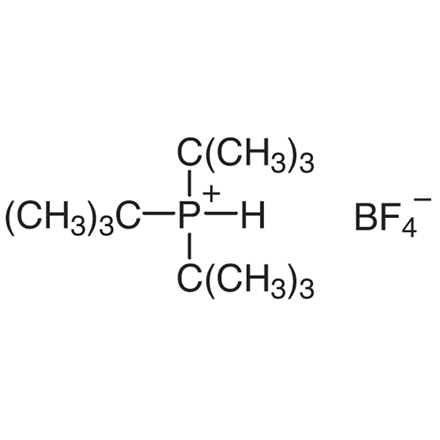Make sure to sign up for an account today for exclusive coupons and free shipping on orders over $75!
Maximum quantity allowed is 999
CAS RN: 131274-22-1 | Numéro de produit: T2584
Tri-tert-butylphosphonium Tetrafluoroborate

Pureté: >98.0%(T)
| Taille | Prix unitaire | Philadelphia, PA | Portland, OR | Japon * | Quantité |
|---|---|---|---|---|---|
| 1G |
$60.00
|
1 | Contactez-nous | ≥100 |
|
| 5G |
$177.00
|
4 | 5 | ≥100 |
|
*Les articles en stock localement sont expédiés dans un délai de 1 à 2 jours. Les articles en stock au Japon peuvent être expédiés depuis un entrepôt aux Etats-Unis dans un délai de 2 semaines. Veuillez contacter TCI pour connaître les délais de livraison des articles qui ne sont pas en stock. Cela ne concerne par les articles réglementés et les articles expédiés sur carboglace.
| Numéro de produit | T2584 |
Pureté / Méthode d'analyse 
|
>98.0%(T) |
| Formule moléculaire / poids moléculaire | C__1__2H__2__8BF__4P = 290.13 |
| Etat physique (20 ° C) | Solid |
Condition de stockage 
|
Room Temperature (Recommended in a cool and dark place, <15°C) |
Emballage Et Conteneur 
|
1G-Glass Bottle with Plastic Insert (Voir l'image) |
| CAS RN | 131274-22-1 |
| Numéro de registre de Reaxys | 8813613 |
| Identifiant de la substance PubChem | 125307337 |
| Numéro MDL | MFCD04039975 |
| Appearance | White to Almost white powder to crystal |
| Purity(Iodometric Titration) | min. 98.0 % |
| NMR | confirm to structure |
| Point de fusion | 261 °C |
| Pictogramme |


|
| Mot de signal | Danger |
| Mentions de danger | H302 : Nocif en cas d'ingestion. H314 : Provoque des brûlures de la peau et des lésions oculaires graves. |
| Conseils de prudence | P501 : Eliminer le contenu/ le conteneur dans une installation d'élimination des déchets agréée. P260 : Ne pas respirer les poussières. P270 : Ne pas manger, boire ou fumer en manipulant ce produit. P264 : Se laver à fond la peau après avoir manipulé. P280 : Porter des gants de protection/ des vêtements de protection/ un équipement de protection des yeux/ du visage. P303 + P361 + P353 : EN CAS DE CONTACT AVEC LA PEAU (ou les cheveux) : Enlever immédiatement tous les vêtements contaminés. Rincer la peau à l'eau / Se doucher. P301 + P330 + P331 : EN CAS D'INGESTION: Rincer la bouche. Ne PAS faire vomir. P363 : Laver les vêtements contaminés avant réutilisation. P301 + P312 + P330 : EN CAS D'INGESTION: Appeler un CENTRE ANTIPOISON ou un médecin en cas de malaise. Rincer la bouche. P304 + P340 + P310 : EN CAS D'INHALATION : Transporter la victime à l'extérieur et la maintenir au repos dans une position où elle peut confortablement respirer. Appeler immédiatement un CENTRE ANTIPOISON ou un médecin. P305 + P351 + P338 + P310 : EN CAS DE CONTACT AVEC LES YEUX: Rincer avec précaution à l'eau pendant plusieurs minutes. Enlever les lentilles de contact si la victime en porte et si elles peuvent être facilement enlevées. Continuer à rincer. Appeler immédiatement un CENTRE ANTIPOISON ou un médecin. P405 : Garder sous clef. |
| Numéro UN (DOT-AIR) | UN1759 |
| Classe d'affichage (DOT-AIR) | 8 |
| Packing Group (TCI-A) | III |
| Numéro du SH (importation) (TCI-A) | 2931.90.9052 |

Used Chemicals
Procedure
Aniline (1.0 g, 10.7 mmol) and 4-chlorotoluene (1.4 g, 11.8 mmol) were dissolved in degassed toluene (10 mL) under nitrogen atmosphere. To this solution was added sodium tert-butoxide (1.54 g, 16.1 mmol), tri-tert-butylphosphonium tetrafluoroborate (31.1 mg, 0.1 mmol) and Pd(dba)2 (61.7 mg, 0.1 mmol, 1.5mol%). The reaction mixture was refluxed for 24 h and cooled to room temperature and quenched with H2O (10 mL). The organic phase was separated and washed with brine (10 mL), dried over MgSO4 (10 g), concentrated under reduced pressure to afford the crude product as a brown liquid. The crude product was purified by column chromatography on silica-gel (hexane : ethyl acetate = 95 : 5) to afford the desired product as a pale yellow crystalline solid (1.21 g, 6.6 mmol, 62%).
Experimenter’s Comments
Toluene was degassed by bubbling with N2 gas for 30 min.
The reaction mixture was analyzed by TLC (hexane : ethyl acetate = 1 : 1, Rf = 0.30) and GC.
Analytical Data (4-Methyl-N-phenylaniline)
1H NMR (400 MHz, CDCl3); δ 7.24-7.20 (t, J = 8.7 Hz, 3H), 7.07 (d, J = 8.7 Hz, 2H), 7.00-6.88 (m, 4H), 6.88-6.84 (m, 1H), 5.58 (s, 1H), 2.29 (s, 3H).
Lead Reference
- Tetramethoxybenzene is a Good Building Block for Molecular Wires: Insights from Photoinduced Electron Transfer
Used Chemicals
Procedure
To a 3-necked 300 mL round bottom flask was charged with diphenylamine (5.01 g, 29.6 mmol, 1.0 eq.), 4-chloroanisole (4.48 g, 31.4 mmol, 1.05 eq.) and degassed toluene (150 mL). To this solution was added Pd2(dba)3 (0.287 g, 0.131 mmol, 1 mol%), tri-tert-butylphosphonium tetrafluoroborate (0.198 g, 0.683 mmol, 2 mol%) and sodium tert-butoxide (6.34 g, 66.0 mmol, 2.2 eq.). The reaction mixture was refluxed for 16 hr under nitrogen atmosphere. After cooled to room temperature, the reaction was diluted with CH2Cl2 (300 mL). The suspension was filtered and the filtrate was dried over Na2SO4 and concentrated under reduced pressure to afford the crude and brown solid. The crude product was purified by silica-gel column chromatography (hexane/EtOAc = 99/1 then 8/1) to afford the light brown solid (7.0 g) containing 10 mol% of diphenylamine. Removal of the residual diphenylamine by recrystallization from hexane (55 mL, 60 °C then 15 °C) gave 4-methoxytriphenylamine as a white solid (5.26 g, 65 %).
Experimenter’s Comments
The reaction mixture was monitored by TLC (EtOAc/hexane = 1/10. Starting materials: Rf = 0.36 (diphenylamine), 0.59 (4-chloroanisole); target product: Rf = 0.46).
Analytical Data(4-Methoxytriphenylamine)
1H NMR (400 MHz, CD2Cl2); δ 7.26-7.17 (m, 4H), 7.10-6.98 (m, 6H), 6.98-6.91 (m, 2H), 6.89-6.82 (m, 2H), 3.79 (s, 3H).
13C NMR (101 MHz, CD2Cl2); δ 156.72, 148.56, 141.00, 129.39, 127.72, 123.12, 122.15, 115.05, 55.77.
Lead References
- Air-Stable Trialkylphosphonium Salts: Simple, Practical, and Versatile Replacements for Air-Sensitive Trialkylphosphines. Applications in Stoichiometric and Catalytic Processes
- An Air and Thermally Stable One- Component Catalyst for the Amination of Aryl Chlorides
Other References
- A Simple Catalytic Method for the Conversion of Aryl Bromides to Arylamines
- Palladium-catalyzed synthesis of arylamines from aryl halides. Mechanistic studies lead to coupling in the absence of tin reagents
- Air-stable trialkylphosphonium salts


References
[Product Highlights] Air-stable Tri-tert-butylphosphine Equivalent
[TCI Practical Example] Buchwald-Hartwig Amination Using Pd2(dba)3 and tBu3P·HBF4
Fiche de sécurité (FDS)
La FDS demandée n'est pas disponible.
Nous contacter pour plus d'informations.
Spécifications
CoA et autres Certificats
Exemple de CoA
Un échantillon CoA pour ce produit n'est pas disponible pour le moment.
Graphiques analytiques

Le tableau analytique demandé n'est pas disponible. Nous sommes désolés pour ce désagrément.





